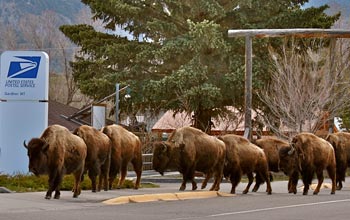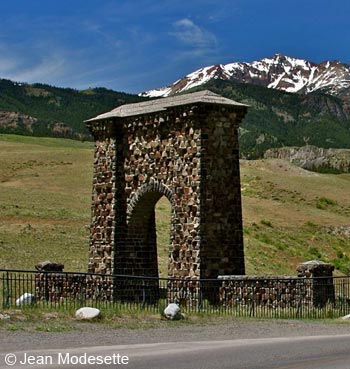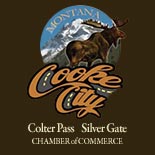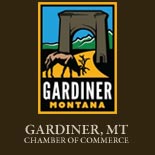Yankee Jim Canyon
Named for an early Montana pioneer who charged a toll for visitors to Yellowstone National Park who crossed his property (on a road that didn't belong to him), Yankee Jim Canyon is a narrow, boulder-strewn stretch of canyon along the Yellowstone River about 10 miles north of Gardiner, Montana.
Jardine / Bear Creek Recreation Area
At an elevation of 6,200 ft., Bear Creek Campground is located five miles above Gardiner at the boundary of the Absaroka-Beartooth Wilderness. Hiking trails penetrate the wilderness, exploring the glacially-carved basins, lakes, and ridges of the Absaroka Range. Open from June 15-October 31, depending on weather. The Bear Creek Ski Trail is an easy climb along Bear Creek Road. It climbs through timber along an old logging road to a meadow on the ridge. This trail is intermittently groomed and is enjoyed by people cross-country skiing and snowshoeing..
Gardiner, Montana
The town of Gardiner was created in 1880 around the first entrance to Yellowstone National Park, providing visitors with goods and services before they set out into the wilderness. Visitors entering the park at Gardiner still pass through Roosevelt Arch, a stone gateway constructed in 1903. Gardiner is the only town with year-round access to Yellowstone National Park.
Mammoth Hot Springs
The headquarters of Yellowstone National Park, Mammoth Hot Springs is home to historic Fort Yellowstone, a hotel, cabins, shops, gas station and other guest services. It's named for the bubbling hot spring terraces with their massive white and orange mineral walls.
Roosevelt Lodge
Built between 1919 and 1936, Roosevelt Lodge was originally a field laboratory for researchers studying the park. It was soon converted into a lodge for the increasing number of tourists visiting Yellowstone by automobile. Today, there are cabins, a store, gas station and corrals where guests can book horseback riding trips, stagecoach adventures and dinner cookouts. If you prefer to dine inside, the Lodge has full restaurant service.
Lamar Valley
The epicenter for wildlife viewing in Yellowstone, the Lamar Valley is inhabited by herds of bison and elk, and the park's population of wolves. It's not uncommon to see birds of prey, pronghorn antelope, bears and moose in the Lamar Valley as well. No matter what time of the year you visit here, you're certain to find groups of wildlife enthusiasts camped out, watching the park's animals moving through the valley.
Colter Pass-Cooke City-Silver Gate
Founded as mining communities, these three towns on the park's eastern edge are especially bustling in the winter. Cross-country skiing, snowmobiling, snowshoeing and other winter activities are great here, thanks to steady snowfall in the colder months. During summer, guests will find a number of shops and outfitters to help them get the most out of their visit to Yellowstone's Northern Range.
By Air
 If you're flying to Yellowstone's Northern Range, you'll want to look at flights to Bozeman, Montana (BZN) or Cody, Wyoming (YRA). Allegiant, Alaska Airlines, Delta Air Lines, Frontier Airlines, United and US Airways service the routes leading to these two airports. Both airports have rental cars available
If you're flying to Yellowstone's Northern Range, you'll want to look at flights to Bozeman, Montana (BZN) or Cody, Wyoming (YRA). Allegiant, Alaska Airlines, Delta Air Lines, Frontier Airlines, United and US Airways service the routes leading to these two airports. Both airports have rental cars available
Year-Round: From Bozeman, travel west on Interstate 90 to Livingston (exit 333), and follow U.S. 89 into Gardiner and the park's northern entrance (the only entrance to Yellowstone National Park open year-round).
Bozeman, Montana: Yellowstone International Airport (BZN) | 406.388.8321
Summer Only: From Cody, follow Highway 120 north for 17 miles, and then turn left onto Highway 296 (Chief Joseph Highway). At the junction with U.S. 212, turn left and follow it west into Cooke City and the park's northeast entrance.
Cody, Wyoming: Yellowstone Regional Airport (YRA) | 307.587.5096
By Car

There are two ways to reach Yellowstone's Northern Range in the summer, but only one route to the park stays open year-round.
Year-Round: To access Yellowstone National Park any time of the year, you'll need to enter through the northern entrance at Gardiner, Montana. From Interstate 90, take exit 333 south at Livingston. Follow U.S. 89 south for approximately 53 miles.
Summer Only: Before the winter snows close the park's northeast entrance, you can access Yellowstone's Northern Range through Cooke City. From Interstates 90 or 25 in Wyoming, travelers can cross the Big Horn Mountains by traveling west on U.S. 14 or U.S. 16. Both highways lead to Cody, Wyoming. At Cody, follow Highway 120 north for about 17 miles, Highway 296 (Chief Joseph Highway) east for about another 20 miles, and U.S. 212 (Bear Tooth Pass Highway) east for about seven miles into Cooke City. Alternatively, travelers can take Interstate 90 west into Montana and take exit 434 at Laurel (about nine miles west of Billings). From there, follow U.S. 212 south for about 108 miles to Cooke City.



